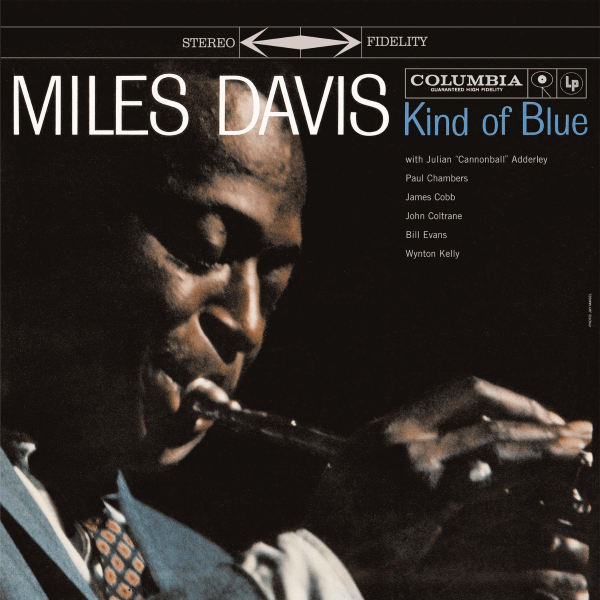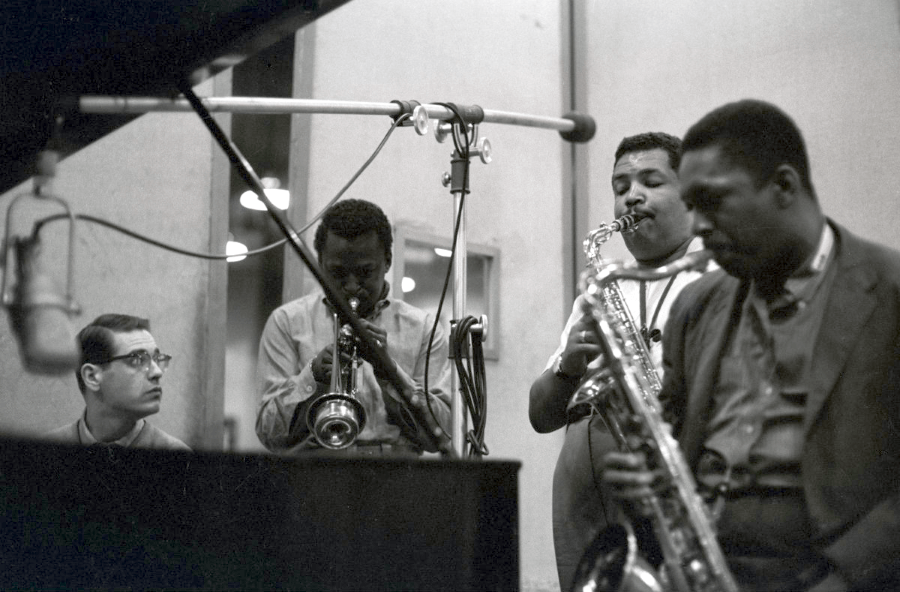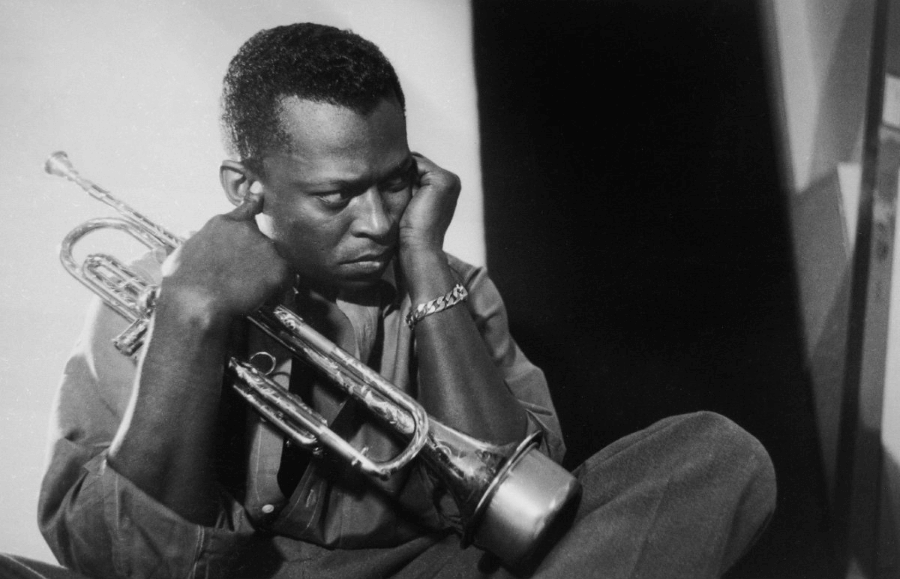It is an instantly recognizable album cover; Davis in a blue suit, lips puffed, about to blow his trumpet; the black backdrop, the Columbia logo, and the album’s title typed in blue. Not only is Kind of Blue considered Miles Davis’s magnum opus and masterpiece, but it is also regularly billed as one of the best albums of all time, not to mention the greatest-ever jazz album.

Miles Davis
Kind Of Blue
(Columbia)
For those whose ears haven’t been blessed with Kind of Blue, what is it about the album that makes it so special? For those who are fans, exactly what is it about this revered record that still thrills and sparkles to this day?
It helps to go back to March 1959 when Miles Davis first entered Columbia 30th Street Studios in New York City to lay down the first sessions for Blue. America was in mourning for Buddy Holly, whose death the previous month was referred to as “the day the music died”. As he tried to map out the future of modern-day jazz (currently in flux, as we explain later) Miles Davis was experimenting with ‘modal’ chords in his music.
Davis was in a real quandary regarding the state of jazz music at the time. During an interview with The Jazz Review the previous year, Davis lamented the shift away from improvisational chords to a more rigid, inflexible, and the conventional way of playing. “The music has gotten thick”, he complained.
At the same time, jazz music had begun the decade with a much more mellow sound. Throughout the 1950s, jazz music would be distinguished by several shifts in styles and movements as the years progressed. Early in the decade, the more relaxed ‘cool jazz’ theme replaced the frenetic sound of bebop, led by the Birth of the Cool compilation album. Who was behind the seminal album? None other than Miles Davis himself.
By the mid-1950s hard bop had come to the fore of the mainstream. This was possibly a pushback against the laid-back sound of cool jazz but also due to the burgeoning popularity of rock ‘n’ roll. Again, Miles Davis was at the forefront of the new sound, debuting his hard-bop single Walkin’ at 1954’s Newport Jazz Festival.
By the time March 4th, 1959 came around, Davis has at his disposal one of the best hard-bop bands around. For avid fans of Kind of Blue, the cast list needs no introduction. Gone were Philly Joe Jones and Red Garland of Davis’ First Great Sextet. Paul Chambers would remain on double bass, Jimmy Cobb on drums, Julian “Cannonball’ Adderley on alto saxophone, John Coltrane on tenor saxophone, with Bill Evans and Wynton Kelly on piano. The bandleader, of course, was trumpeter Miles Davis.

One year previously (almost to the day), Davis had wrapped up the final session for Milestones in the very same studio. Milestones was a seminal album whose modern sound showed the metamorphosis of jazz music at the time. The album displays bebop and post-bop songs, yet the title track demonstrates the first example of the ‘modal jazz’ sound that would remain prevalent over the next few years to come.
Kind of Blue was his first attempt at a complete album with the new sound. The music showed Davis’ increasing interest in his craft, heavily influenced by George Russell’s Lydian Chromatic Concept of Tonal Organization. In adopting the new form, the songs disposed of a pre-ordained chord progression and instead relegated chords to the background of the songs. By using scales and modes, the songs themselves were given space to breathe and invited much more creativity and experimentation from the musicians.
As Davis himself explained, limiting a jazz song to chords led to repetition. Usually, for jazz albums, the supporting musicians would be provided with harmonies or chords to follow, if not a completed score. This invited improvisation but only within a set framework. For Kind of Blue, Davis issued his musicians with an outline of each track he’d written, along with accompanying scales that best represented their style.
The musicians were given these scales and melody lines mere hours before the sessions. It would be this deviation from jazz tradition that Davis would credit with the album’s success. By allowing his musicians to go against the grain, he said, they thrived on the creative freedom afforded. As he wrote in his autobiography Miles: “If you put a musician in a place where he has to do something different from what he does all the time . . . that’s where great art and music happens.”
Kind of Blue – Tracks by Tracks
So What
The album opens with the 9-minute “So What”, perhaps the album’s purest form of modal jazz displayed by the record. The track is largely formed of improvisation, although thanks to the rhythm section the core of the song remains consistent. Central to the song is a gripping riff that is produced by a ‘call and response’ between the double bass and the rest of the band. This riff produces an effortless harmony at the heart of the song, paving the way nicely for the improvisations. The song also gave birth to a chord structure known as the ‘So What chord’, later used by John Coltrane.
Freddie Freeloader
The second track “Freddie Freeloader” employs the 12-bar blues. As such, Davis drafted in Wynton Kelly on the piano, likely due to his work with Billie Holliday. The track, now a jazz standard, is played in a three-part harmony comprising Davis’ trumpet, “Cannonball”’s alto sax, and Coltrane’s tenor sax. At the beginning of the song, you can hear Davis halting the music due to the tempo being too fast for his liking. Intriguingly, however, subsequent live recordings of the song would be played at a faster tempo.
Blue in Green
“Blue in Green” follows next. The song, a jazz ballad, was actually composed by pianist Bill Evans. However, legend has it that when the pianist approached Davis to enquire about royalties, the bandleader wrote him a cheque for $25. The song is played in a ten-bar beat and is distinctive with its beautiful piano.
All Blues
“All Blues” was recorded in just one take using a slightly different 12-bar blues chord progression. Here, the rhythm section allows the trumpet and both saxophones the freedom to provide the 12-bar theme that makes up the song. Davis’ trumpet is muted for the main section of the song, although he removes this to perform his solo. The best display of modal music here is the track’s melody, which uses chromatic notes. Originally recorded as an instrumental piece, lyrics were later added by civil rights activist Oscar Brown Jr. The song is also the longest on the record, clocking in at eleven and a half minutes.
Flamenco Sketches
The album’s final track “Flamenco Sketches”, co-written by Davis and Evans, is the best example of open-form composition. Five modal scales were issued and Davis is very strict in carrying out the modal scales during his opening chorus. Part of the song’s beauty is that we can hear solos interchanging, with each musician signaling to the other to start playing their solo a second before they do so. Davis’ talent as a bandleader is fully on display here as he allows the musicians total creative license with their scale solos. However, the song is never in danger of falling apart. The response from the musicians is sonically moving and a befittingly beautiful end to a masterpiece of an album.
Not only would the album influence jazz generations to come, but it also opened up different genres to experiment with the expansive and detached sound that features throughout the record. Subsequent musicians who would cite the album as an influence reads like the Music Hall of Fame: James Brown, Sly Stone, The Velvet Underground, Brian Eno, and Moby.
The album was released with a positive response, but nowhere near the later acclaim it would earn. The release date of 17th August was hotly anticipated and met by hordes of fans around the world queueing outside record shops to get their hands on their version of the record. To date, the album has achieved quintuple platinum status in the USA and double platinum in Australia, Italy, Poland, and the UK.
Many future albums would be influenced by Kind of Blue, although John Coltrane’s immediate subsequent releases in the five years following the record (notably My Favorite Things, Impressions, and A Love Supreme) are perhaps the stand-out records for their work in progressing the sound.
Kind of Blue – Info
Tracklisting
a1. “So What” (9:22)
a2. “Freddie Freeloader” (9:46)
a3. “Blue in Green” (5:27)
b1. “All Blues” (11:33)
b2. “Flamenco Sketches” (9:26)

Miles Davis: trumpet; Julian “Cannonball” Adderley: alto saxophone; John Coltrane: tenor saxophone; Bill Evans: piano; Wynton Kelly: piano (2); Paul Chambers: double bass; James Cobb: drums
Kind of Blue was released on August 17, 1959